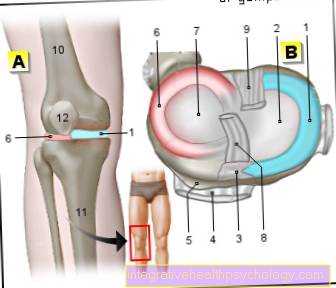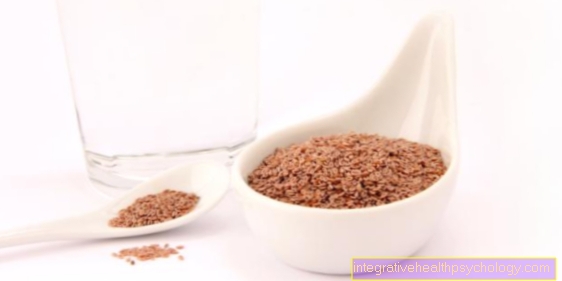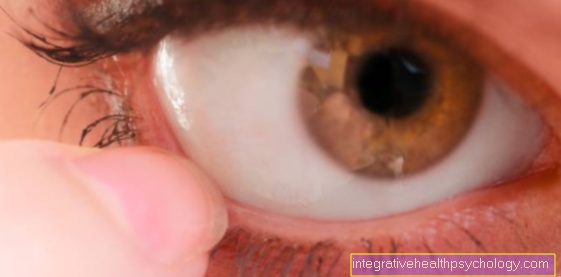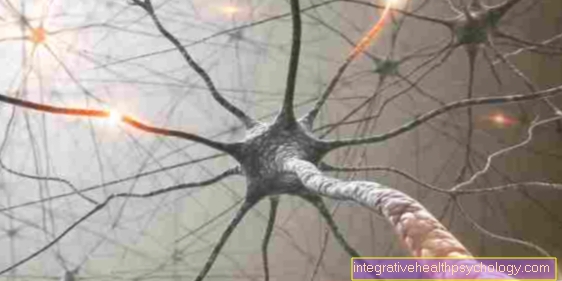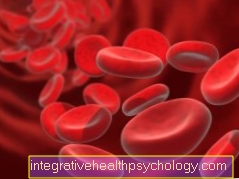Cushing's disease
definition
In Cushing's disease, a mostly benign tumor of the pituitary gland leads to an increased cortisol level in the body. The tumor cells produce large quantities of a messenger substance, the so-called adrenocorticotrope hormone, or ACTH for short. This acts on the cells in the adrenal cortex and causes them to produce cortisol.
Since the tumor cells produce an enormously increased amount of ACTH, the cells of the adrenal cortex are also stimulated to overproduce. This ultimately leads to a greatly increased cortisol occurrence, which is referred to in medical jargon as hypercortisolism.

The reasons
The cause of the development of Cushing's disease is usually a tumor in the pituitary gland. The tumor arises from cell proliferation or an uninhibited cell proliferation from incorrectly controlled cells. The tumor cells are impaired in their function.
In contrast to the healthy cells of the pituitary gland, they produce abnormally increased amounts of ACTH, a messenger substance that affects other organs, especially the adrenal gland. This reacts to the oversupply with increased cortisol production, which in large quantities can be accompanied by a strong deviation and change in various body functions.
Find out all about the topic here: Pituitary gland tumor.
The diagnosis
The diagnosis of Cushing's disease is usually made with a blood test. It looks for the cortisol in the blood. In addition, the ACTH value can be determined, which is characteristically increased in Cushing's disease.
Certain tests can be performed to differentiate between Cushing's disease and other diseases that are also associated with increased cortisol. In this case, the so-called Dexamethasone test. An increased amount of cortisol can also be found in the 24-hour urine collection.
The head is also imaged. As a rule, an MRI of the head is made, on which the tumor in the pituitary gland can then be visualized.
Find out all about the topic here: ACTH.
The symptoms
Overproduction of cortisol, which occurs in the context of Cushing's disease, can cause a variety of symptoms. The most common changes are named below; it should be noted that not every symptom is absolutely necessary to infer Cushing's disease.
A redistribution of body fat is particularly typical, which manifests itself in a so-called trunk obesity, a full moon face and a bull's neck. The cortisol also has an effect on the bones, which causes them to lose their density and the symptoms of osteoporosis arise.
The muscles also suffer from the increased influence of cortisol and are broken down more quickly, especially in the extremities. The body reacts more sensitively to sugar or glucose, the blood sugar level rises more strongly after the ingestion of sugar than is usual in healthy people. The skin is also affected. Typical are thinning of the skin, formation of stretch marks, wound healing disorders and skin bleeding.
The psyche can also suffer from increased cortisol levels. Those affected can show changes in mood up to and including depressive episodes.
In the context of Cushing's disease, in addition to an increased cortisol level, there is also a change in the ACTH level in the blood. This leads to an increased production of sex hormones, especially male hormones, the so-called androgens. This is particularly noticeable in women who then suffer from menstrual disorders or increased hair growth, especially on the face. ACTH and cortisol also have an influence on blood pressure. The interaction with other hormones leads to an increase in blood pressure, which is then noticeable as high blood pressure.
The difference between Cushing's disease and Cushing's syndrome
Cushing's syndrome includes any disease or condition that is associated with elevated cortisol levels. It makes no difference whether the cortisol was supplied externally, i.e. through medication, or whether it was caused by an overproduction of cortisol in the body.
The Cushing syndrome describes hypercortisolism, which can have various causes.
Cushing's disease, in turn, refers explicitly to an increased cortisol level, which is caused by increased ACTH production, mostly in the context of a pituitary gland tumor. Both terms usually encompass the same symptoms. Cushing's disease can also have an impact on sex hormones, especially male hormones (androgens). The overproduction can lead to disorders in the menstrual cycle and increased masculine hair growth, especially on the face, especially in women.
Find out more about the topic here: The typical symptoms of Cushing's syndrome.
The course of the disease
Cushing's disease usually presents with the symptoms mentioned above. In the context of a pituitary gland tumor, these occur either suddenly or gradually. This has to do with how fast the tumor grows and how cortisol production is influenced.
If the cortisol levels are very high, the cardiovascular system can be strongly influenced. Patients with high cortisol levels also show abnormally high blood pressure particularly often. In the long run, this favors diseases such as a heart attack or a stroke. Because of this, introductory therapeutic measures are also so important.
During the surgical removal of a tumor, the ACTH-über producing cells are removed and those affected usually have a normal cortisol level again after the procedure - they are therefore considered cured. If surgery is out of the question as a therapy, the cortisol level is reduced, for example with medication, which also leads to the alleviation of symptoms and reduces the unwanted negative impact on the cardiovascular system.
The further course of the disease cannot generally be predicted in general for patients who have been treated with medication, as this is also influenced by other factors such as underlying diseases or age.
Also read the article: Side effects of cortisone.
The therapy
In Cushing's disease, surgical removal of the pituitary gland tumor is usually performed. If a surgical procedure is not possible, there are other treatment measures that can be considered.
These include, for example, proton irradiation of the tumor tissue or the administration of certain drugs. The drug therapy includes cortisol-lowering substances. They are supposed to reduce the typical symptoms caused by hypercortisolism.
You can find more on this topic here: Pituitary gland tumor.
Prognosis
In the case of Cushing's disease, which is caused by a tumor in the brain ankle and can be treated surgically, a normal life expectancy can usually be expected. If surgical removal is not possible, it is important to lower the cortisol levels in the blood with medication.
A permanently increased cortisol level has a negative effect on the cardiovascular system. Above all, the increased blood pressure can lead to complications such as a heart attack or stroke, which can significantly reduce the life expectancy of those affected.
Cushing's disease in dogs
Cushing's disease can also occur in dogs. As in humans, the most common trigger is a tumor in the pituitary gland responsible for the increased cortisone production. The animals show various symptoms, including weight gain, hair loss, increased urination, pronounced thirst behavior, muscle weakness and thinned and more pigmented skin.
Cushing's disease in dogs is usually treated with drugs that reduce cortisol production. The drug therapy must be lifelong so that the dog does not suffer from the typical Cushing symptoms.
With consistent treatment and regular blood tests by the veterinarian, a good therapy success can usually be expected.
Find out all about the topic here: Cushing syndrome in dogs.
Cushing's disease in cats
Cats show almost the same symptoms as dogs for Cushing's disease. These include, among other things, a loss of hair or fur, an increase in body weight, muscle wasting and an increased feeling of thirst and hunger. "Thinning" skin and increased urination are also possible symptoms.
However, in contrast to dogs, cats often only become apparent to their owners in very late stages or with already very pronounced symptoms. That is why the animals often only come to the vet when they are already very sick.
Cats can also be treated with cortisol-reducing medication, but in contrast to dogs, the symptoms do not always decrease.
In general, no statement can be made about the prognosis for cats. This depends on both the severity of the disease and the rest of the cat's health.







